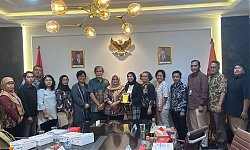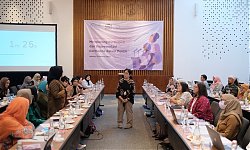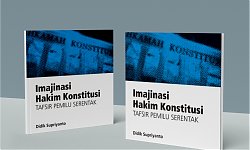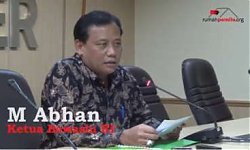Corruption by the Minister of Social Affairs, Juliari Batubara in the run-up to the 2020 elections adds to the long record of President Joko Widodo's era corruption minister. Previously at the end of November 2020, corruption of lobster seed export was carried out by Minister of Marine Affairs and Fisheries (KKP) Edhy Prabowo. These two corruption cases are reminiscent of the corruption of power plant projects by Idrus Marham (Minister of Social Affairs) and the corruption of grant funds by Imam Nahrawi (Minister of Youth and Sports).
Keep in mind, the four ministers, are members of the President's supporting coalition party. That is, the President as the holder of prerogatives, it is necessary to evaluate the way in determining who will fill the cabinet. The president needs to weigh the professionalism of the minister and his competence, not just about rewarding supporters who are already sweating.
Unfortunately, there were several ministers from professional circles who showed competence, instead replaced by cadres of political parties such as Edhy Prabowo's predecessor, Susi Pudjiastuti. But understandably, the selection of cabinet members also depends on political lobbies. Supporting parties certainly ask for rations, in addition to awards, as well as so that the executive is not disturbed by the legislature.
Multiparty Presidential Dilemma
This kind of problem we often experience, especially post-reform that frees up political life. Soeharto's post-election freedom encouraged the proliferation of political parties in Indonesia, which also implicated the party system. Previously Indonesia used a simple multiparty system, or even according to Giovanni Sartori, a single-party system. The party system then transformed into an extreme multiparty system with dozens of political parties in one parliament.
In addition, post-Reformation we are also increasingly committed to the presidential system adopted as well as the separation of powers. However, there seems to be a contradiction between the purification of the presidential system as the excesses of the amendment of the 1945 Constitution, and the extreme multiparty system as the implications of post-Reformation political liberation.
According to many experts, the presidential system is not matched with a multiparty system. His second marriage will cause new problems. Mainwaring (1993), said the marriage of these two systems would be vulnerable to the democratic stability of a country, as evidenced by several Latin American countries that tried to marry both and failed. Furthermore, because more than two political parties, then logically there is no dominant parliament and encourage the president to build a coalition. But the coalition being built will be very fluid, depending on how the parliament deals and the president.
As a result, according to Hanta Yudha (2010), it implies many political compromises such as political intervention in presidential policy to the degradation of the president's prerogative in appointing ministers. A real example of this phenomenon is, for the ministerial chair to the commissioner of SOEs as a payment from the support of the parliament and "sedative pills" in the Dpr.
This phenomenon can be explained mathematically through the calculation of the Rae Index which sees the large fragmentation of interests in parliament and the Laakso and Taagepera Index (LTI) which sees the number of effective parties. When we look at the application in Indonesia, from the 2004 to 2019 elections, rae index is always at 0.99 and LTI is quite volatile, ranging from 6-8. More on the following table:
RI and LTI in Post-Reformation Indonesia
| Period | Rae Index (Party Sytem Fragmentation) | Laakso and Taagepera Index (Effective Number of Parties) |
| 2004-2009 | 0.9995 | 7.08 |
| 2009-2014 | 0.9998 | 6.12 |
| 2014-2019 | 0.9997 | 8.16 |
| 2019-2024 | 0.9997 | 7.47 |
Source: Kahfi Adlan Hafiz, 2020
From this figure, Indonesia's presidency is far from stable. Based on trials conducted by Scott Mainwaring (1993), stable presidential states have RI numbers in the range of 0.4 to 0.6 and LTI in the range of 1.8 to 2.6. That is, simplification of the number of parties becomes important.
Engineering the Democratic Party
The large number of political parties is certainly incompatible with our commitment to the presidential system. However, limiting the formation of political parties and even incorporating them in the party fusion system as President Suharto did, is certainly not the solution. The commitment to freedom of association must be grasped in its right hands.
Therefore, there needs to be other solutions to limit the number and amount of fragmentation of parliament in the Dpr. The goal is to establish a party system more in line with the reality of our presidency. This can be found through the engineering of the electoral system and its elements, which will affect the limiting of the number of political parties in the Dpr.
There are several elements of the election that can be engineered such as district magnitude, threshold, electoral formula, and even the model of the electoral system. District magnitude itself can be engineered by reducing the number of seats in one dapil, which was originally 3-10 seats, to 3-8 seats only, with the consequence of the number of dapil multiplied. This implies a competitive climate created in one election, so the chances of smaller parties gaining seats are running low.
In addition, the change of sound conversion method into chair, from quota-hare method to sainte-lague is an progression. The hare method is operated with the Voter Dividing Number (BPP), which produces the remaining votes, and the tendency of the remaining votes to be given to minor parties. While sainte-lague is more effective in the context of simplification of the party because the vote is dissiciped with the CPM and does not use large remainders so that the party that gets a small vote, is more likely to be excluded in contesting seats.
Next engineer thresholds. There are two models that have been practiced in Indonesia, parliamentary threshold (PT) and electoral threshold (ET). ET becomes a very effective threshold to reduce the number of parties because, this model selects the parliament starting from participation in the election so that the participants of the election can be more limited. Meanwhile, PT, operated by providing a threshold of votes for election participants, in order to be included in the counting of seats. Indeed PT is also effective, but unfortunately what happens is the number of votes produced by the parliament is excluded, which is wasted. It is noted that almost 11% of the votes were wasted as a result of this system (Hafiz, 2020).
In addition to the engineering of the electoral element, the use of proportional systems in Indonesian elections also needs to be evaluated. Because, the proportional system has not been able to simplify the party system. In the context of simplification of the party system, According to Pippa Norris (1997), the majority/plurality system is certainly the main choice because the system embraces single-member districts or one-representation dapil, so that the competition in the dapil is tighter because only one party passes. However, this system is certainly not compatible with its application to multicultural and multiethnic countries such as Indonesia, because the chosen ones represent only the majority groups and vulnerable minority groups, do not have representatives in the Dpr.
With these conditions, mixed election systems can be used with various variations. In essence, it combines a majority system and a proportional system. For example the parallel system, this system is operated by dividing the total seats in the Dpr into two parts. The first section is filled using the district system, while the rest is divided by proportional system. Thus, the operation of the mixed electoral system, and in proportion to the engineering of some elements of the above elections, can decrease the amount of fragmentation and decrease the number of effective political parties in parliament. This will certainly imply a reduction in the president's compromise policy and stable governance. []
KAHFI ADLAN HAFIZ
Pemerhati pemilu











